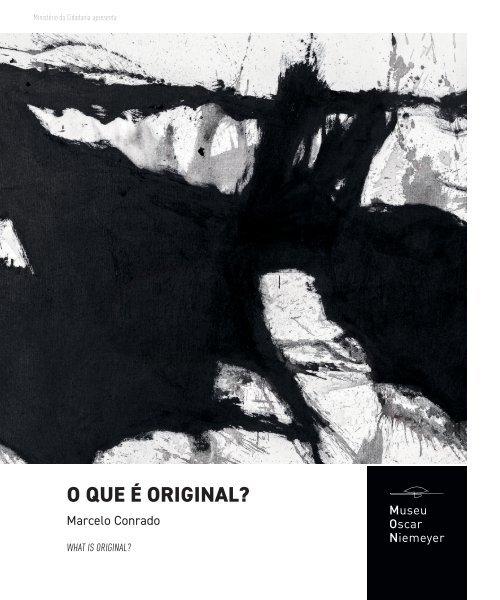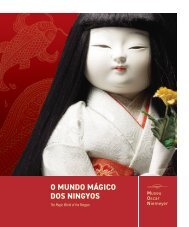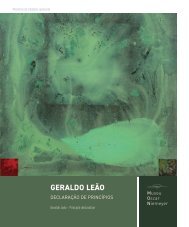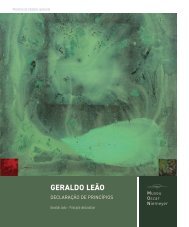Marcelo Conrado - O que é Original?
- No tags were found...
You also want an ePaper? Increase the reach of your titles
YUMPU automatically turns print PDFs into web optimized ePapers that Google loves.
Minist<strong>é</strong>rio da Cidadania apresenta<br />
O QUE É ORIGINAL?<br />
<strong>Marcelo</strong> <strong>Conrado</strong><br />
WHAT IS ORIGINAL?
Too much perfection is a mistake<br />
Perfeição demais <strong>é</strong> um erro<br />
2017<br />
E o <strong>que</strong> vem depois?<br />
And what comes next?<br />
2017<br />
Maria Jos<strong>é</strong> Justino<br />
Curadora
ENGLISH VERSION<br />
When the artist <strong>Marcelo</strong> <strong>Conrado</strong> asks, “what<br />
is original” he makes us wonder about a<br />
universe of anonymous information that is<br />
all around us, ranging from a random dialog<br />
between friends to graffiti, from messages<br />
shared in social networks to traditional truck<br />
bumper sentences.<br />
It is a pleasure for the Oscar Niemeyer Museum<br />
to perform this exhibition, which certainly will<br />
spark interesting reflections in each one of us.<br />
Doctor in the art authorship subject, <strong>Conrado</strong><br />
brings the <strong>que</strong>stioning about the concept<br />
of originality on contemporary art to the<br />
Museum. However, what actually is art and<br />
authorship? What does not belong to anyone<br />
belongs to everyone?<br />
For him, the most important thing are not<br />
the answers, but each individual reflection<br />
sparked by the pieces. For such a goal, the<br />
artist presents us pictures collected from<br />
image databases, which, after receiving<br />
anonymous sentences, make us wonder.<br />
In a fine balance between image and text,<br />
he also exhibits his paintings. These, on the<br />
other hand, through the influence of several<br />
other artists, keep alive the main <strong>que</strong>stion that<br />
guides his proposal—what is original to you?<br />
Juliana Vellozo Almeida Vosnika<br />
Chief Executive Officer<br />
Museu Oscar Niemeyer<br />
WHAT IS ORIGINAL?<br />
It is impossible to enter into this theme without<br />
referring to the reflections of Walter Benjamin<br />
when he treats the subject of the artist as<br />
creator, of technical reproducibility of art<br />
and the concept of aura. For him, the aura<br />
is possible only in the uni<strong>que</strong> work, the one<br />
that keeps authenticity, which is based on the<br />
ritual. Aura is the DNA of art. The possibility<br />
of reproduction via new technologies affects<br />
the aura, particularly painting. Reproduction<br />
techni<strong>que</strong>s, by stripping the object from its<br />
veil, alter the function of art. These vicissitudes<br />
open the way both for the attempt of art for art<br />
and for the exercise of political art.<br />
With the advent of information technology<br />
(technologies that Benjamin did not reach),<br />
the artist seeks to distance herself from the<br />
aura. New symbologies take shape, reaching<br />
the identification of art with the concept, in<br />
which there is no more place for art for art –<br />
art becomes related to politics, anthropology,<br />
sociology, philosophy, etc. “Pure” art no<br />
longer makes sense.<br />
<strong>Conrado</strong> suffers from these influxes. But<br />
his adventure through art does not mean<br />
a passage from visuality (painting) to<br />
conceptual art (photos-phrases). Far from it,<br />
the poetic and the political purpose coexist<br />
in it. The contemplative aesthetic coexists<br />
with the permutative: painting, photos, texts,<br />
ideas. <strong>Conrado</strong> balances in two strands.
In painting, he exercises his expression,<br />
emotion, subjectivity. But needs to express a<br />
desire for rationality, which consumes in the<br />
photos/texts. By appropriating symbologies<br />
– images and words – builds a trap and<br />
imprisons the viewer, who is compelled<br />
to reflect. Where are these pictures from?<br />
Somewhere, at the same time, many of them<br />
are accessible to everyone, available via<br />
the internet or scattered on the street. The<br />
authors? Lost in time.<br />
In these photos/phrases <strong>Conrado</strong> has a<br />
precision in the choice. But if there is a<br />
selection of phrases and images, this impels<br />
us to the <strong>que</strong>stion: in the choice does not<br />
remain an authorship? In painting there<br />
is no doubt, the artist is the author. And<br />
in those other experiences, where is the<br />
authorship? Who is the creator? And what<br />
is original? <strong>Conrado</strong> believes that, even if<br />
he appropriates another work, the artist,<br />
in resignifying, can be original. In this way,<br />
authorship becomes fluid.<br />
<strong>Conrado</strong> settles on the borders between<br />
aesthetic and social, between art and politics.<br />
All of his recent work balances on the idea of<br />
ownership, from images to ideas. Dissolution<br />
of the object (art) and the creator-consumer<br />
relations; appropriation and anonymity; the<br />
interaction of the public with the artist’s<br />
proposals. Rite of passage: birth and death,<br />
entering another dimension. <strong>Conrado</strong>, like<br />
Isis, collecting fragments of human existence,<br />
asserts himself as a compassionate being,<br />
sensitive to human tragedies, able to share<br />
his discoveries and findings.<br />
He took advantage of loose images in<br />
life, freed from possession. Everything is<br />
available, accessible on social networks or<br />
random encounters: random phrases caught<br />
somewhere – on trucks, motorcycles, movies,<br />
literature, the street or prose with friends.<br />
Everything is a source. With rare exceptions,<br />
does not modify them, quotes them literally<br />
(photos and phrases) as he finds them,<br />
enjoying what can arise from the image and<br />
text junction. This confrontation creates<br />
disturbance, activates the brain, stimulates<br />
sensitivity. But <strong>Conrado</strong> does not forget the<br />
balance between painting and the concept:<br />
not only gesture, not just rationality. As<br />
Fernando Pessoa recalls: “One must also have<br />
no philosophy at all. With philosophy there<br />
are no trees, just ideas”.<br />
Reflection and joy. <strong>Conrado</strong> gives us back the<br />
pleasure of feeling and thinking.<br />
Maria Jos<strong>é</strong> Justino<br />
Curator
Museu Oscar Niemeyer<br />
Terça a domingo, 10h às 18h<br />
Venda de ingressos at<strong>é</strong> as 17h30<br />
Venda de ingresso online: museuoscarniemeyer.org.br<br />
Entrada franca para maiores de 60 e menores de 12 anos.<br />
Período expositivo / Exhibition period<br />
11 18 02<br />
ABR > AGO SALA<br />
APR AGO ROOM<br />
2019<br />
From Tuesday through Sunday, from 10 a.m. to 6 p.m.<br />
Ticket sale until 5:30 p.m.<br />
Online ticket sales: museuoscarniemeyer.org.br<br />
Free admission to seniors over 60 and children under 12.<br />
Rua Marechal Hermes, 999<br />
Centro Cívico · Curitiba · PR<br />
Tel.: 41 3350 4400<br />
museuoscarniemeyer<br />
museuoscarniemeyer<br />
museuoscarniemeyer.org.br<br />
Capa/cover detalhe/detail<br />
Sem título Untitled, 2018/2019<br />
Acrílica e nanquim sobre tela Acrylic and India ink on canvas<br />
patrocínio<br />
empresa amiga<br />
media partner<br />
realização<br />
SECRETARIA DA COMUNICAÇÃO<br />
E DA CULTURA





